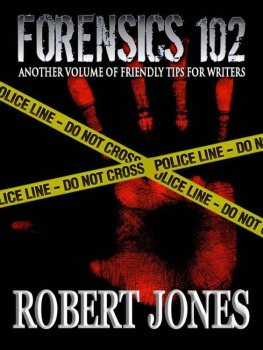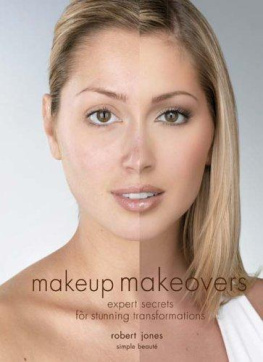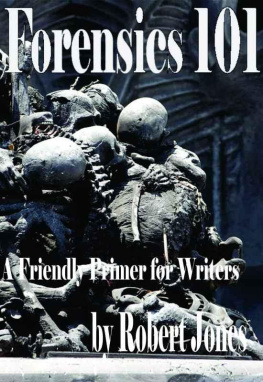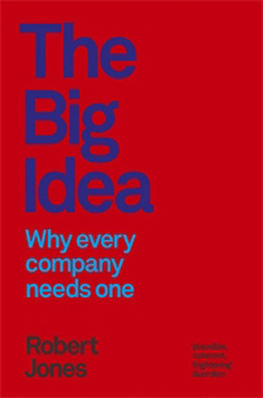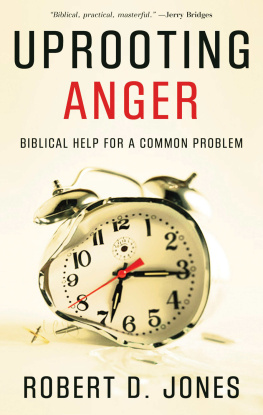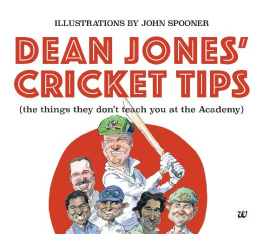Robert Jones - Forensics 102: Another Volume of Friendly Tips for Writers
Here you can read online Robert Jones - Forensics 102: Another Volume of Friendly Tips for Writers full text of the book (entire story) in english for free. Download pdf and epub, get meaning, cover and reviews about this ebook. year: 2012, publisher: Crossroad Press, genre: Detective and thriller. Description of the work, (preface) as well as reviews are available. Best literature library LitArk.com created for fans of good reading and offers a wide selection of genres:
Romance novel
Science fiction
Adventure
Detective
Science
History
Home and family
Prose
Art
Politics
Computer
Non-fiction
Religion
Business
Children
Humor
Choose a favorite category and find really read worthwhile books. Enjoy immersion in the world of imagination, feel the emotions of the characters or learn something new for yourself, make an fascinating discovery.
- Book:Forensics 102: Another Volume of Friendly Tips for Writers
- Author:
- Publisher:Crossroad Press
- Genre:
- Year:2012
- Rating:4 / 5
- Favourites:Add to favourites
- Your mark:
- 80
- 1
- 2
- 3
- 4
- 5
Forensics 102: Another Volume of Friendly Tips for Writers: summary, description and annotation
We offer to read an annotation, description, summary or preface (depends on what the author of the book "Forensics 102: Another Volume of Friendly Tips for Writers" wrote himself). If you haven't found the necessary information about the book — write in the comments, we will try to find it.
Forensics 102: Another Volume of Friendly Tips for Writers — read online for free the complete book (whole text) full work
Below is the text of the book, divided by pages. System saving the place of the last page read, allows you to conveniently read the book "Forensics 102: Another Volume of Friendly Tips for Writers" online for free, without having to search again every time where you left off. Put a bookmark, and you can go to the page where you finished reading at any time.
Font size:
Interval:
Bookmark:

Robert Jones

Digitial Edition published by Crossroad Press
2012 / Robert Jones
Cover Design By: David Dodd
Cover image courtesy of:
http://chain.deviantart.com/
This eBook is licensed for your personal enjoyment only. This eBook may not be re-sold or given away to other people. If you would like to share this book with another person, please purchase an additional copy for each person you share it with. If you're reading this book and did not purchase it, or it was not purchased for your use only, then you should return to the vendor of your choice and purchase your own copy. Thank you for respecting the hard work of this author.
The first volume of this series, Forensics 101 A Friendly Primer for Writers , is also available
Try any title from CROSSROAD PRESS use the Coupon Code FIRSTBOOK for a one-time 20% savings! We have a wide variety of eBook and Audiobook titles available.
Find us at: http://store.crossroadpress.com
**Editor: This foreword is the same as in volume 1. These essays have appeared online at http://www.storytellersunplugged.com where the series is ongoing. This second volume continues where the first left off, so I have included the author's foreword intact"**
C ontrary to what one might think after viewing some of the forensic investigation shows on television programs that show off the latest in modern (and sometime wishful) forensic science devices and techniques, forensics has a long history. From a time of slow advance in ancient Babylon when fingerprints were pressed into clay tablets to cement business transactions, through a time in circa 250 BC when Erasistratus, a Greek physician noticed that, when his patients lied, their pulse rates increased, through the time in 44 BC when Antistius, a Roman physician, counted the 23 stab wounds in Julius Caesar's body to establish a cause of death, to the present time, the rate of advancement in forensics has been steadily increasing. Various specialized fields have developed and expanded to include subfields. As a result, the number and size of documents that describe the growing number of forensic specialties has seemingly grown exponentially.
Writers, especially fiction writers, are frequently unfamiliar with the forensic documents and have no time or desire to get familiar with many of them. In view of this, writers would most likely find concise, easily read, explanatory documents of assistance. Fortunately, you will not have to mount much of a search to find such a document. If you are reading this, you have it effectively in hand.
I t is generally known that we can recognize many persons with a fair amount of accuracy by the sounds of their voices alone. The distinct sounds are a function not only of the physical configuration of our vocal cords but also by the size and shape of our nasal, oral and velo-pharyngeal cavities. (The latter cavity simply refers to the mechanism that directs the passage of sound energy and air pressure to the other two cavities.) Sounds are, of course, also a function of the positioning of our tongues, soft palates, lips and jaws. Vibrations of muscles inside our mouths and throats also contribute to the creation of unique sounds. Even our teeth are involved, as clearly evidenced by the annually popular song, "All I Want for Christmas Is My Two Front Teeth."
Recordings of voices can provide a source of evidence to aid various forensic investigations. Voice analysis was used during World War II by military intelligence personnel and, in the 1950s, by the FBI. Its use became widely known by the public in the early 1970s during the Watergate investigations. As with some other identification techniques, it can be used to scientifically verify a match between a particular person's voice and, for example, that of a person unknowingly recording a bomb threat or a robbery plan. This is referred to in the trade as an "identification." An analysis result that scientifically proves that a person's voice and a recorded voice sample do not match is referred to as an "elimination."
As we have seen at home and in countless movies, voices can be captured by a simple telephone answering device, by a tiny microphone secreted within a coat button or an olive, or by a directional microphone such as those we might have seen near the sidelines at football games. These microphones were used to capture quarterback play calls (and sometimes an exchange of sincere complimentary remarks between defensive and offensive linemen). Conversations can be captured at a fair distance using a laser beam aimed at a window in a room in which a conversation is taking place. Voice sounds vibrate the window, and the window vibrations modulate the laser beam as the beam is reflected. The reflected laser beam is then demodulated, and the conversation is recorded.
As can be readily discerned, the sound of a voice varies over time in frequency and intensity. A voice spectrograph instrument can analyze the sound of a recorded voice and produce a graphic representation (spectrograph) of it that visually illustrates these factors. Spectrographs then can be compared in an attempt to determine whether the recorded sounds are from the same person. Researchers discovered that error rates varied, of course, as a function of many factors including environmental noise, the properties of a speaker's voice, the psychological state of the speaker, the attempts that might be made by the speaker to alter his or her voice, the analysis techniques applied and, of great importance, the skills of an examiner.
Although basic methods of spectrographic analysis have remained about the same, during the last few decades, such associated techniques as critical listening (listening and then evaluating), waveform analysis, spectrum analysis, magnetic media enhancement and speed correction have been evolving to detect stress and other patterns in a person's voice. Analysts analyze recordings of a subject's speech by comparing the sounds and then by visually comparing spectrographs of the sounds. Both of these techniques, of course, are subjective. While the analyses of what were once, and sometimes still are, referred to as "voice prints" are not recognized as being a science as exact as the analyses of finger prints, they can be useful when screening suspects and also when combined with other evidence.
Spectrographic analysis remains controversial to the point that only thirty-five of fifty states find it admissible as evidence. This is comparable to the professional and legal standing of polygraphs (commonly known as lie detectors). The accuracy of spectrographic analysis was called into public question in 2002. The news station Al Jazeera released a tape recording of what was alleged to be a telephone message from bin Laden. After analyzing the tape, the U.S. Central Intelligence Agency and the National Security Agency verified the tape as being authentic. Interestingly, the Institute for Perceptual Artificial Intelligence in Switzerland, using biometric software, claimed there was a 50% to 60% likelihood that the tape was not genuine. We might never learn where bin Laden is... or even if he IS. (* Editor's note: This entry was, or course, written prior to the events we are all to familiar with at this point)
Next pageFont size:
Interval:
Bookmark:
Similar books «Forensics 102: Another Volume of Friendly Tips for Writers»
Look at similar books to Forensics 102: Another Volume of Friendly Tips for Writers. We have selected literature similar in name and meaning in the hope of providing readers with more options to find new, interesting, not yet read works.
Discussion, reviews of the book Forensics 102: Another Volume of Friendly Tips for Writers and just readers' own opinions. Leave your comments, write what you think about the work, its meaning or the main characters. Specify what exactly you liked and what you didn't like, and why you think so.

